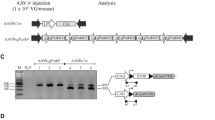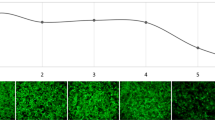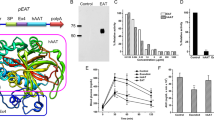Abstract
The liver is an important target organ for gene transfer due to its large capacity for synthesizing serum proteins and its involvement in numerous genetic and acquired diseases. Previously, we and others have shown that an efficient gene transfer to liver cells in vivo can be achieved by an intravenous injection of plasmid DNA using a hydrodynamics-based procedure. In this study, we systematically characterized the expression of transgene encoding a secretory protein in mouse. Using human α1-antitrypsin (hAAT) gene as a reporter, we demonstrate that the serum level of hAAT can reach as high as 0.5 mg/ml by a simple tail vein injection of 10–50 μg plasmid DNA into a mouse. The serum hAAT reaches the peak level 1 day after DNA injection and then declines during the following 2 to 4 weeks to 2–5 μg/ml, a level which persists for at least 6 months. Southern analysis of extracted DNA and RT-PCR analysis of RNA from the liver reveal that hAAT gene is active and present as episomal form after 6 months. These results suggest that the hydrodynamics-based transfection procedure provides a valuable tool for screening genes for therapeutic purposes in whole animals.
This is a preview of subscription content, access via your institution
Access options
Subscribe to this journal
Receive 12 print issues and online access
$259.00 per year
only $21.58 per issue
Buy this article
- Purchase on Springer Link
- Instant access to full article PDF
Prices may be subject to local taxes which are calculated during checkout






Similar content being viewed by others
References
Ferry N et al. Retroviral-mediated gene transfer into hepatocytes in vivo Proc Natl Acad Sci USA 1991 88: 8377–8381
Kaleko M, Garcia JV, Miller AD . Persistent gene expression after retroviral gene transfer into liver cells in vivo Hum Gene Ther 1991 2: 27–32
Rettinger SD et al. Liver-directed gene therapy: Quantitative evaluation of promoter elements by using in vitro retroviral transduction Proc Natl Acad Sci USA 1994 91: 1460–1464
Bowles NE et al. A simple and efficient method for the concentration and purification of recombinant retrovirus for increased hepatocyte transduction in vivo Hum Gene Ther 1996 7: 1735–1742
Kitten O, Cosset FL, Ferry N . Highly efficient retrovirus-mediated gene transfer into rat hepatocytes in vivo Hum Gene Ther 1997 8: 1491–1494
Jaffe HA et al. Adenovirus-mediated in vivo gene transfer and expression in normal rat liver Nat Genet 1992 1: 372–378
Li Q et al. Assessment of recombinant adenoviral vectors for hepatic gene therapy Hum Gene Ther 1993 4: 403–409
Engelhardt JF, Ye X, Doranz B, Wilson JM . Ablation of E2A in recombinant adenoviruses improves transgene persistence and decreases inflammatory response in mouse liver Proc Natl Acad Sci USA 1994 91: 6196–6200
Yao SN et al. Adenovirus-mediated transfer of human factor IX gene in immunodeficient and normal mice: evidence for prolonged stabilitya nd activity of the transgene in liver Viral Immunol 1996 9: 141–153
Schiedner G et al. Genomic DNA transfer with a high-capacity adenovirus vector results in improved in vivo gene expression and decreased toxicity Nat Genet 1998 18: 180–183
Snyder RO et al. Persistent and therapeutic concentrations of human factor IX in mice after hepatic gene transfer of recombinant AAV vectors Nat Genet 1997 16: 270–276
Pnnazhagan S et al. Adneo-associated virus 2-mediated gene transfer in vivo: organ-tropism and expression of transduced sequences in mice Gene 1997 190: 203–210
Nakai H et al. Adeno-associated viral vector-mediated gene transfer of human blood coagulation factor IX into mouse liver Blood 1998 91: 4600–4607
Wu GY et al. Receptor-mediated gene delivery in vivo. Partial correction of genetic analbuminemia in Nagase rats J Biol Chem 1991 266: 14338–14342
Cotton M et al. High-efficiency receptor-mediated delivery of small and large (48 kilobase) gene constructs using the endosome-disruption activity of defective or chemically inactivated adenovirus particles Proc Natl Acad Sci USA 1992 89: 6094–6098
Wagner E et al. Coupling of adenovirus to transferrin-polylysine/DNA complexes greatly enhances receptor-mediated gene delivery and expression of transfected genes Proc Natl Acad Sci USA 1992 89: 6099–6103
Takehara T et al. Expression of the hepatitis C virus genome in rat liver after cationic liposome-mediated in vivo gene transfer Hepatology 1995 21: 746–751
Tomita N et al. In vivo gene transfer of insulin gene into neonatal rats by the HVJ-liposome method resulted in sustained transgene expression Gene Therapy 1996 3: 477–482
Hara T, Tan Y, Huang L . In vivo gene delivery to the liver using reconstituted chylomicron remnants as a novel nonviral vector Proc Natl Acad Sci USA 1997 94: 14547–14552
Moscioni AD et al. In vivo regional delivery of retrovirally mediated foreign genes to rat liver cells: need for partial hepatectomy for successful foreign gene expression Surgery 1993 113: 304–311
Yang Y, Ertl HC, Wilson JM . MHC class I-restricted cytotoxic T lymphocytes to viral antigens destroy hepatocytes in mice infected with E1-deleted recombinant adenoviruses Immunity 1994 1: 433–442
Yang Y et al. Cellular immunity to viral antigens limits E1-deleted adenoviruses for gene therapy Proc Natl Acad Sci USA 1994 91: 4407–4411
Barr D et al. Strain related variations in adenovirally mediated transgene expression from mouse hepatocytes in vivo: comparisons between immunocompetent and immunodeficient inbred strains Gene Therapy 1995 2: 151–155
Dong JY, Fan PD, Frizzell RA . Quantitative analysis of the packaging capacity of recombinant adeno-associated virus Hum Gene Ther 1996 7: 2101–2112
Liu F, Song YK, Liu D . Hydrodynamics-based transfection in animals by systemic administration of plasmid DNA Gene Therapy 1999 6: 1258–1266
Zhang G, Budker V, Wolff JA . High levels of foreign gene expression in hepatocytes after tail vein injections of naked plasmid DNA Hum Gene Ther 1999 10: 1735–1737
Robin W et al. Structure and variation of human α1-antitrypsin Nature 1982 298: 329–334
Budker V, Zhang G, Knechtle S, Wolff JA . Naked DNA delivered intraportally expresses efficiently in hepatocytes Gene Therapy 1996 3: 593–598
Wolff JA et al. Long-term persistence of plasmid DNA and foreign gene expression in mouse muscle Hum Mol Genet 1992 1: 363–369
Hickman MA et al. Gene expression following direct injection of DNA into liver Hum Gene Ther 1994 5: 1477–1483
Malone RW et al. Dexamethasone enhancement of gene expression after direct hepatic DNA injection J Biol Chem 1994 269: 29903–29907
Zhang G et al. Expression of naked plasmid DNA injected into the afferent and efferent vessels of rodent and dog livers Hum Gene Ther 1997 8: 1763–1772
Garver RI et al. Production of glycosylated physiologically ‘normal’ human alpha 1-antitrypsin by mouse fibroblasts modified by insertion of a human alpha 1-antitrypsin cDNA using a retroviral vector Proc Natl Acad Sci USA 1987 84: 1050–1054
Sambrook J, Fritsch EF, Maniatis T . Molecular Cloning: A Laboratory Manual Cold Spring Harbor Laboratory Press: New York 1989 pp 1.21–1.24
Liu F, Qi H, Huang L, Liu D . Factors controlling efficiency of cationic lipid-mediated transfection in vivo via intravenous administration Gene Therapy 1997 4: 517–523
Acknowledgements
We thank Professor David Edwards for critical reading of this manuscript. This work was supported in part by NIH grant CA72925.
Author information
Authors and Affiliations
Rights and permissions
About this article
Cite this article
Zhang, G., Song, Y. & Liu, D. Long-term expression of human alpha1-antitrypsin gene in mouse liver achieved by intravenous administration of plasmid DNA using a hydrodynamics-based procedure. Gene Ther 7, 1344–1349 (2000). https://doi.org/10.1038/sj.gt.3301229
Received:
Accepted:
Published:
Issue Date:
DOI: https://doi.org/10.1038/sj.gt.3301229
Keywords
This article is cited by
-
Controlling Obesity and Metabolic Diseases by Hydrodynamic Delivery of a Fusion Gene of Exendin-4 and α1 Antitrypsin
Scientific Reports (2019)
-
Effective Prevention of Liver Fibrosis by Liver-targeted Hydrodynamic Gene Delivery of Matrix Metalloproteinase-13 in a Rat Liver Fibrosis Model
Molecular Therapy - Nucleic Acids (2016)
-
Optimized human factor IX expression cassettes for hepatic-directed gene therapy of hemophilia B
Frontiers of Medicine (2015)
-
Novel electric power-driven hydrodynamic injection system for gene delivery: safety and efficacy of human factor IX delivery in rats
Gene Therapy (2013)
-
Parameters Affecting Image-guided, Hydrodynamic Gene Delivery to Swine Liver
Molecular Therapy - Nucleic Acids (2013)



